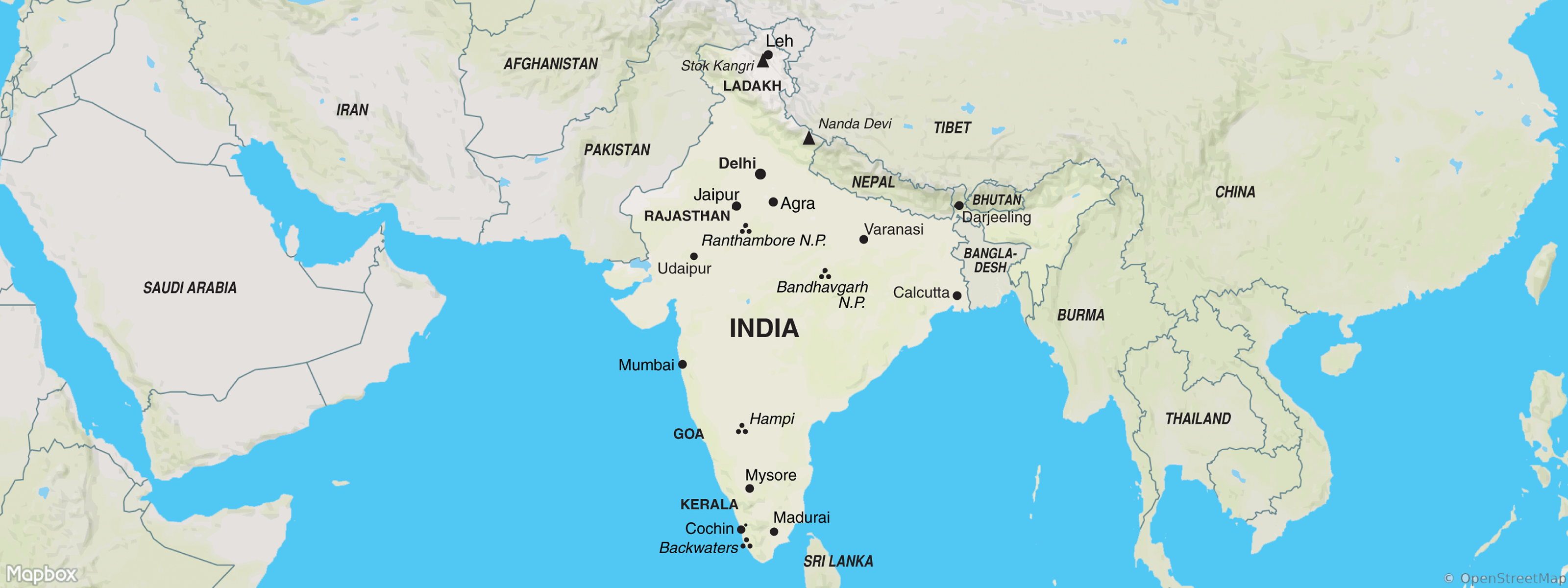A feast for the senses. Where colour, aroma, culture and charm collide
India Tiger Safari

Shape your adventure: With Extensions, every beginning and ending is yours to create. Learn More.
A feast for the senses. Where colour, aroma, culture and charm collide

India’s cities and towns are an exciting, captivating mix of sights, sounds, and smells. Our India trips allow you to take all that in. But the country has a more serene side, too. For a tranquil break, visit the south to enjoy its rolling tea plantations, hill stations, and golden, palm-thronged beaches.
If you’re venturing north beyond Rajasthan, you’ll find themselves in a region few have ever heard of: Ladakh. It’s a land of jagged, sky-scraping peaks and remote villages nestled in the lush foothills of Himalayan giants.
Then there’s the astounding sunrise over the Taj Mahal – our guides know the very best spots to watch from – or the swirl of colour along the River Ganges during morning prayers. Adventure-seekers might prefer to stand amid the mighty Himalaya, or in a four-wheel drive spotting their first tiger in the wild. These are the unique experiences that Exodus tours to India offer.
But for all the country’s natural wonders and beauty, it’s the local people who make holidays here memorable. India evokes emotion like no other place, capable of making your heart sing one moment, and cry out the next. A trip to India isn’t really a holidays, more voyages of discovery. Once there, the country will grab you and leave an indelible mark on your soul.
No matter if you’re looking to explore the dense forest, breath-taking mountains, beautiful lakes of Meghalaya, Assam and Nagaland or head out on an Indian tiger safari at some of the country’s best tiger parks, we have something for every kind of traveller – couples, seasoned explorers and families alike.
Want to book something a little more bespoke? Why not speak to the private adventures team here at Exodus, chat online or request a brochure to begin planning the adventure of a lifetime.
Some might say you can never spend enough time in India, owing to the number of places to visit and things to do here. But we feel 9 days is a good amount of time to get around the main highlights and some lesser-known gems without rushing your trip to India. If you want to get a more in-depth insight into the country and really immerse yourself in the culture, history and nature, then you might want to extend your holiday to 14 or 15 days.
If you want to avoid the intense heat and monsoon season, the best time for India tours is during October, November, February, March and April. The summer months can get extremely hot and heavy rain can be expected.
India is a vast country with a wealth of diverse sites, wildlife, landscapes and culture, which could take a lifetime to discover it all. So, unless you’ve got a lot of time on your hands for travelling, we’d recommend spending a couple of weeks at a time really getting to explore the country in depth.
If you want to explore this captivating country and discover its intriguing sights, wildlife and culture, the top 10 best India tours include:
Cycle Kerala and Tropical India
Yes, all of our India tours are guided to ensure you get the best experience possible and see all of the sights that this colourful country has to offer. If you are heading on a culture style trip to India you and the group will embark on your adventure with a local leader. Should you choose one of our fantastic cycling holidays in India, you will have full vehicle support throughout.
Our wonderous India holidays start at 7 days and can extend to as long as 16 days, should you wish to completely immerse yourself in this beautiful country.

Get regular inspiration straight to your inbox from Exodus’ experts.